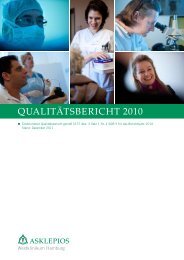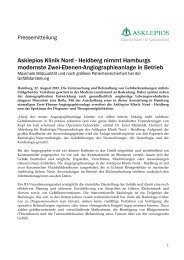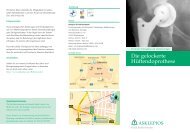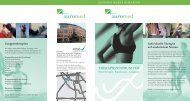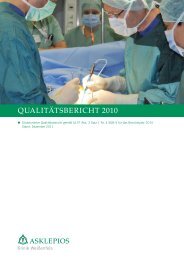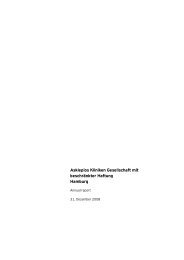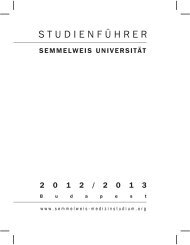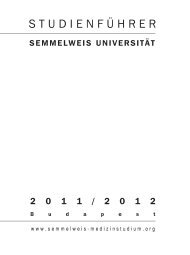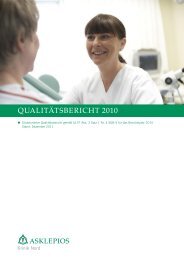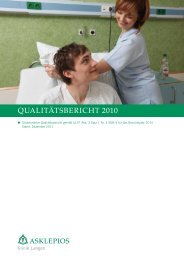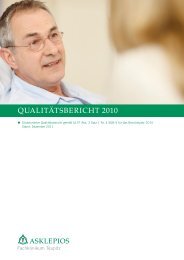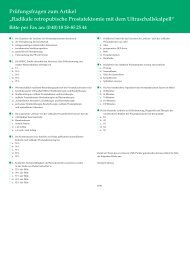Download Sammelmappe - Asklepios
Download Sammelmappe - Asklepios
Download Sammelmappe - Asklepios
Erfolgreiche ePaper selbst erstellen
Machen Sie aus Ihren PDF Publikationen ein blätterbares Flipbook mit unserer einzigartigen Google optimierten e-Paper Software.
The need to tackle the challenges is<br />
urgent. In 2002, 10 percent of the world’s<br />
population was 60 years of age or older.<br />
By 2050, that percentage will more than<br />
How do people around the<br />
world experience aging?<br />
double to 21 percent, or nearly two billion<br />
people. 1<br />
As the elderly population increases,<br />
so will the incidence of chronic disease.<br />
In the United States, while 25% of the<br />
overall population has multiple chronic<br />
conditions, 67% of those over age 65<br />
have two or more chronic illnesses. 2<br />
These<br />
illnesses are costly. Today, on average, as<br />
much as half of all healthcare spending<br />
in developed countries goes to treat<br />
diseases and conditions of the elderly. 3<br />
What are the needs of the elderly, and how can technology address those<br />
needs? In 1999, Intel researchers began focusing on healthcare needs and<br />
how technology could address them. Three years later, Intel established<br />
the Proactive Health Lab that explored the ways in which technology can<br />
support the daily health and wellness needs of people in their homes and<br />
everyday lives. This research project continues to expand to this day. Its<br />
mission: to examine the social and cultural similarities and differences in<br />
people’s experience of aging and health, and identify opportunities for new<br />
technologies to address the challenges posed by an aging global population.<br />
clinicians and family caregivers, can help<br />
to meet the challenges of an aging global<br />
Cost is not the only concern. As the<br />
elderly population is increasing, the pool<br />
population. Such technologies could<br />
ease the burden on strained healthcare<br />
of healthcare professionals is shrinking<br />
worldwide. By 2020, the United States<br />
systems while providing peace of mind<br />
and meaningful engagement for the<br />
alone is expected to face a shortage of<br />
aging population. Our research into the<br />
technology needs of the aging is focused<br />
more than one million nurses and as many<br />
as 200,000 doctors. 4<br />
Most other countries<br />
on advancing personal health technologies,<br />
improving care in clinical environments,<br />
are projected to experience similarly<br />
critical shortfalls in the coming decades.<br />
and promoting standards and policies that<br />
enable innovation and interoperability<br />
At Intel, we believe that new technologies,<br />
designed with an explicit focus on the<br />
across the healthcare ecosystem.<br />
needs of older adults, as well as their<br />
1 United Nations, “Population Aging 2002.”<br />
2 Anderson G. Chronic Conditions: Making the Case for Ongoing Care. Baltimore, MD: Partnership for Solutions; Sept. 2004. Available<br />
at: www.partnershipforsolutions.org/DMS/files/chronicbook2004.pdf Accessed Feb. 13, 2007.<br />
3 Stephane Jacobzone and Howard Oxley, “Ageing and Health Care Costs,” International Politics and Society, January 2002.<br />
4 Richard A. Cooper, M.D., “Weighing the Evidence for Expanding Physician Supply,” Annals of Internal Medicine, November 2, 2004.<br />
1



